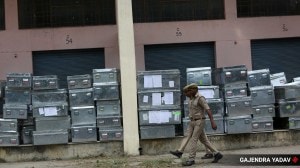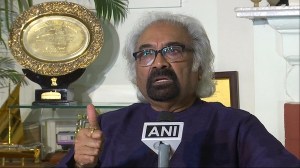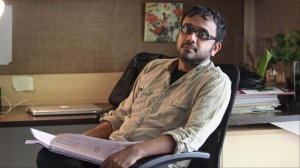- India
- International
Bring water, gain goodwill
In arid Marathwada, politicians who took the initiative on water supply are reaping the benefits.
As a rule, conversations with Marathwada’s politicians must always turn to water. That is even more so this election, coming barely two years after one of Maharashtra’s worst drought in years and with an alleged Rs 70,000-crore irrigation scam continuing to be fodder for mockery of the 15-year Congress-NCP regime.
And since good news, like water, is scarce in these parts, it’s de rigueur for discussions on water to turn into long lamentations on corruption and delays.
That’s why BJP office-bearer in Aurangabad Pradeep Patil’s account sounds unusual. With not a single paisa in government aid, with only donations from locals, 20-odd villages in Aurangabad and Jalna built nearly 40 check dams along rainwater streams after the drought of 2012. A few political activists and local residents roped in the expertise of Suresh Khanapurkar, known for the ‘Shirpur pattern’ check dams, and raised funds for some rudimentary mud-and-stone structures and a few cement plugs.
These now hold rainwater, prevent it from flowing away and allow it to percolate. The results are startling in the five villages along a 16-km stretch along Aurangabad-Jalna Road. Gadejalgaon village, for example, harvested 2,000 quintals wheat in 2013, apart from sweet lime, pomegranate, corn and millet.
Patil was among the chief movers of the project, also channeling a Rs 50 lakh contribution from Devgiri Cooperative Bank, of which he is a director. “All the work was done in a span of 40 days. And we need to replicate this everywhere possible because depleting groundwater is the biggest concern for areas prone to drought and scarce rainfall,” says Patil, 40.

The people’s cooperation the villagers are so proud of today was designed to keep out not just government officials’ hand-wringing but also corruption. “We have proved that government estimates are hugely inflated. You don’t need hundred-crore projects, you only need an honest assessment of the need and simple, cost-effective solutions,” says Patil. The 40-odd dams cost Rs 4.5 crore, including a large one near Jalna city that cost over Rs 1 crore.
When they told a visiting government team in 2013 that one of the smaller structures was built at a little over a lakh, the officials reportedly insisted the villagers were lying. “Their estimate was that the job would cost at least four times as much,” says Vithal Sadre, who owns 20 acres in Gadejalgaon. He had lost 65 per cent of his crop in 2012 but is beaming now despite scanty rain.
Vithal too is with the BJP, and a panchayat samiti chairperson. Patil is a protégé of a former BJP minister (1995-1999), Haribhau Bagade, now contesting from Phulambri from where he has won four times and lost twice.
Despite Patil’s insistence that there was no political motive behind the effort, the BJP is harvesting rich dividends from these now lush farmlands in Gadejalgaon, Satana, Dudhal, Karajgaon, Shevga and Devni Wahegaon. In the 20-odd villages impacted, an estimated 12,000 farmers, mostly with small and marginal land holdings, have benefited. For a party seen largely as urban, and in an area where the Shiv Sena has been traditionally the much stronger party, the BJP actvists who were part of the initiative have earned immense goodwill in this belt.
Two assembly constituencies are set to gain from the effort, Phulambri and Jalna. In fact, among the big donors for the largest dam was former Shiv Sena MLA Arjun Khotkar from Jalna, who too was a minister in the Sena-BJP government. Khotkar donated Rs 21 lakh for the check dam just outside Jalna city, now named after Bal Thackeray.
Jalna city
Sixty km from Aurangabad, Arjun Khotkar is talking to a group of traders in a druggist’s store in Jalna city, where he is again the Sena candidate against sitting Congress legislator Kailash Gorantyal.
“The sitting MLA calls himself Jal Samrat or Water Emperor,” he says of the Congress’s Kailash Gorantyal. “But I can show you detailed documentation to prove that he actually tried to seek a court stay on the project.”
He is referring to the Jayakwadi-Jalna water supply project over which he filed a public interest litigation in 2008. There were allegations of corruption, but the project was finally given the go-ahead, though the internal distribution network is still to be completed.
The city still gets municipal water supply erratically, sometimes once in 10 days. It is one of several growing urban centres that survive almost entirely on tubewells or borewells and water tankers, the latter growing into an industry. Jalna city needs about 50 million litres daily; the municipality supplies a little over a third of that.
In fact, for Phulambri’s Patil too, it all started when he visited Jalna a few days before the opening of the Jalna branch of Devgiri Cooperative Bank. Jalna has a small and closely knit community of wealthy industrialists and traders, and he was invited to lunch with a potential patron for the new branch. “They had an annual turnover running into a few hundred crores, and they served me lunch on a paper plate. It was strange,” Patil says. Jalna city was then receiving municipal water supply once in 40 days. The domestic help of Patil’s help spent Rs 250 of the Rs 300 she earned daily on water.
But there also were efforts by local industrialists in the area of water conservation. In 2010, they’d banded together to form the Ghanewadi Jal Sanrakshan Manch. Among the chief movers was tea manufacturer Rameshbhai Patel. “Jalna was continuing to survive on water from a tank built 80 years ago, the Ghanewadi talav. From 40,000 people then, the city’s population has grown to 3 lakh-plus, but there’s been no new source of water supply,” says Patel. “When some of my industrialist friends and I formed the Ghanewadi Jal Sanrakshan Manch to first desilt that tank, we took out a pheri in the streets asking for donations. Even beggars gave us Rs 5.”
The first year, 2010, they got the use of one earth-mover machine as government dole. In subsequent years they did not even need to seek donations. Donors came forward happily.
The group participated in Patil and Khotkar’s efforts with the check dams. “The pipeline project is still to give results, but groundwater levels have improved tremendously,” says Patel. “Municipal water still comes only once a week, but there is no real crisis now.”
Khotkar says 4,000 tubewells in Jalna are functioning well. One of his big ideas is to now turn the Balasaheb Bandhara just outside the city into a green zone with 4,000 trees and a jogging track and more, a picnic spot for Jalna’s residents.
Political will
Water, says Bagade, is something with which it is indeed possible to show results of political will to Marathwada’s electorate. “When I was minister, I took an interest in spreading awareness on the need for water retention in this region. We built 600 percolation tanks in Phulambri taluka,” says the 70-year-old, who lives in a sparse four-room home in the city.
Amid the success of these initiatives here and in Dhule, and following exhortations from local representatives, former chief minister Prithviraj Chavan announced a Rs-8-crore fund for more check dams in Jalna. Work is still to begin.
“That we were able to do this at a local level with donor funds should make us think about irrigation funding and Marathwada’s sequential drought. There are simple solutions that have huge benefits,” says Patil. “It appears that there just has not been political will in the last 15 years.”
Apr 24: Latest News
- 01
- 02
- 03
- 04
- 05







































